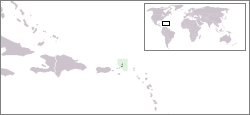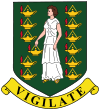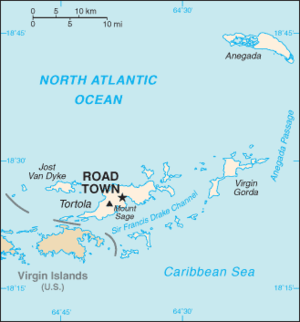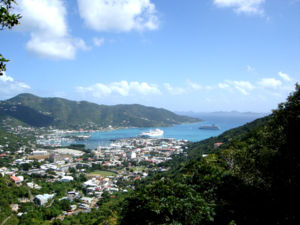British Virgin Islands
2007 Schools Wikipedia Selection. Related subjects: Central & South American Countries; Countries
|
|||||
| National motto: Vigilate (Be Watchful) |
|||||
 |
|||||
| Official language | English | ||||
| Political status | Non- sovereign, British overseas territory | ||||
| Capital | Road Town | ||||
| Monarch | Queen Elizabeth II | ||||
| Governor | David Pearey | ||||
| Chief Minister | Orlando Smith | ||||
| Area - Total - % water |
Ranked 216th 153 km² 1.6% |
||||
| Population - Total (2005) - Density |
Ranked 215th 22,016 260/km² |
||||
| Currency | US dollar | ||||
| Time zone | UTC -4 | ||||
| National anthem | " God Save the Queen" | ||||
| Internet TLD | .vg | ||||
| Calling Code | 1-284 | ||||
The British Virgin Islands (BVI) is a British overseas territory, located in the Caribbean to the east of Puerto Rico. The islands make up part of the Virgin Islands archipelago (the remainder constituting the U.S. Virgin Islands; see also Spanish Virgin Islands).
The British Virgin Islands consist of the main islands of Tortola, Virgin Gorda, Anegada and Jost Van Dyke, along with over 50 other smaller islands and cays. Around 15 of the islands are inhabited. The largest island, Tortola, is approximately 12 miles (19 km) long and 3 miles (5 km) wide. The islands have a total population of about 22,000. Road Town, the capital, is situated on Tortola.
History
The Virgin Islands were first settled by Arawak Indians from South America around 100 BC (though there is some evidence of Amerindian presence on the islands as far back as 1500 BC ). The Arawaks inhabited the islands until the 15th century when they were displaced by the more aggressive Caribs, a tribe from the Lesser Antilles islands, after whom the Caribbean Sea is named. (Some historians, however, believe that this popular account of warlike Caribs chasing peaceful Arawaks out of the Caribbean islands is rooted in simplistic European stereotypes, and that the true story is more complex.)
The first European sighting of the Virgin Islands was by Christopher Columbus in 1493 on his second voyage to the Americas. Columbus gave them the fanciful name Santa Ursula y las Once Mil Vírgenes (Saint Ursula and her 11,000 Virgins), shortened to Las Vírgenes (The Virgins), after the legend of Saint Ursula.
The Spanish Empire acquired the islands in the early 16th century, mining copper on Virgin Gorda, and subsequent years saw the English, Dutch, French, Spanish and Danish all jostling for control of the region, which became a notorious haunt for pirates. During the process of colonisation the native Amerindian population was decimated.
The Dutch established a permanent settlement on the island of Tortola in 1648. In 1672, the English captured Tortola from the Dutch, and the British annexation of Anegada and Virgin Gorda followed in 1680. Meanwhile, over the period 1672–1733, the Danish gained control of the nearby islands of St. Thomas, St. John and St. Croix.
The British islands were considered principally a strategic possession, but were planted when economic conditions were particularly favourable. The British introduced sugar cane which was to become the main crop and source of foreign trade, and slaves were brought from Africa to work on the sugar cane plantations. The islands prospered economically until the growth in the sugar beet crop in Europe and the United States significantly reduced sugar cane production.
In 1917, the United States purchased St. John, St. Thomas and St. Croix from Denmark for US$17 million, renaming them the United States Virgin Islands. Subsequently, the British renamed the islands they controlled as the British Virgin Islands.
The British Virgin Islands were administered variously as part of the Leeward Islands Colony or with St. Kitts and Nevis, with an Administrator representing the British Government on the Islands. Separate colony status was gained for the Islands in 1960 and the Islands became autonomous in 1967. Since the 1960s, the Islands have diversified away from their traditionally agriculture-based economy towards tourism and financial services, becoming one of the richest areas in the Caribbean.
Politics
Executive authority in British Virgin Islands is invested in The Queen and is exercised on her behalf by the Governor of the British Virgin Islands. The Governor is appointed by the Queen on the advice of the British Government. Defence and Foreign Affairs remain the responsibility of the United Kingdom.
The Constitution of the Islands was introduced in 1971. The Head of Government is the Chief Minister, who is elected in a general election along with the other members of the ruling government as well as the members of the opposition. An Executive Council is nominated by the Chief Minister and appointed by the Governor. There is a unicameral Legislative Council made up of 13 seats.
The current Governor is David Pearey (since 2006). The current Chief Minister is Orlando Smith (since June 17, 2003) who is a member of ruling National Democratic Party (NDP). The main opposition is the Virgin Islands Party (VIP).
Geography
The British Virgin Islands comprise around 60 semi-tropical Caribbean islands, ranging in size from the largest, Tortola (approximately 12 miles by 3 miles), to tiny uninhabited islets. They are located in the Virgin Islands archipelago, a few miles east of the U.S. Virgin Islands. The North Atlantic Ocean lies to the north of the islands, and the Caribbean Sea lies to the south. Most of the islands are volcanic in origin and have a hilly, rugged terrain. Anegada is geologically distinct from the rest of the group and is a flat island composed of limestone and coral.
In addition to the four main islands of Tortola, Virgin Gorda, Anegada, and Jost Van Dyke, other islands include:
- Beef Island
- Cooper Island
- Ginger Island
- Great Camanoe
- Great Thatch
- Guana Island
- Mosquito Island
- Necker Island
- Norman Island
- Peter Island
- Salt Island
Climate
The British Virgin Islands enjoy a sub-tropical climate, moderated by trade winds. Temperatures vary little throughout the year: typical daily maxima are around 29°C (84°F) in the summer and 25°C (77°F) in the winter. Rainfall averages about 115 cm (45 in) per year, higher in the hills and lower on the coast. Rainfall can be quite variable, but the wettest months on average are September to December. Hurricanes occasionally hit the islands, with the hurricane season running from June to October.
Subdivisions
Economy
The British Virgin Islands enjoys one of the more prosperous economies of the Caribbean region, with a per capita GDP of around $38,500 (2004 est.) .
The British Virgin Islands is highly dependent on tourism, which accounts for 45% of national income. The islands are a popular destination for U.S. citizens, with around 350,000 tourists visiting annually (1997 figures). Tourists frequent the numerous white sand beaches, visit The Baths on Virgin Gorda, snorkel the coral reefs near Anegada, experience the well-known bars of Jost Van Dyke, or charter yachts to explore the less accessible islands.
Substantial revenues are also generated by the registration of offshore companies. As of 2004, over 550,000 companies were so registered. In 2000 KPMG reported in its survey of offshore jurisdictions for the United Kingdom government that over 41% of the world's offshore companies were formed in the British Virgin Islands. Since 2001, financial services in the British Virgin Islands have been regulated by the independent Financial Services Commission.
Agriculture and industry account for only a small proportion of the islands' GDP. Agricultural produce includes fruit, vegetables, sugar cane, livestock and poultry, and industries include rum distillation, construction and boatbuilding.
Since 1959, the official currency of the British Virgin Islands has been the US dollar, also used by the United States Virgin Islands.
Demographics
The population of the Islands is around 21,730 at 2003. The majority of the population (83%) are Afro-Caribbean, descended from the slaves brought to the Islands by the British. Other large ethnic groups include those of British and European origin.
The 1999 census reports:
- Black 83.36%
- White 7.28% (includes British, Portuguese, & Syrian/Lebanese)
- Mixed 5.38%
- East Indian 3.14%
- Others 0.84%
- White 7.28% (includes British, Portuguese, & Syrian/Lebanese)
The islands are predominantly Protestant Christian (86%). The largest individual denominations are Methodist (33%), Anglican (17%), and Catholic (10%).
Transport
Being a small group of islands, transportation is limited. There are 113km of roads. The main airport (Terrence B. Lettsome Airport, also known as Beef Island Airport) is located on Beef Island, which lies off the eastern tip of Tortola. Virgin Gorda and Anegada have their own smaller airports. The main harbour is in Road Town.




